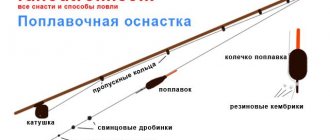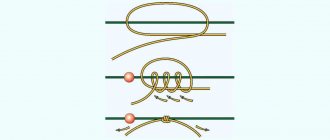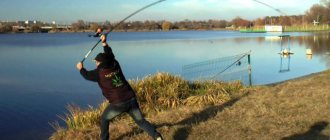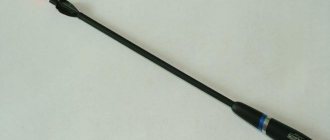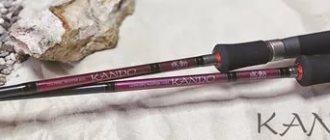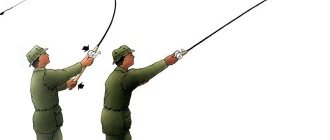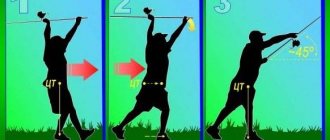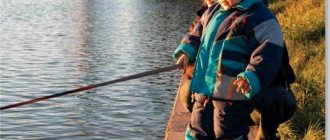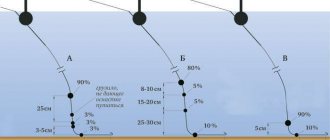A float for long casting makes it possible to fish at a considerable distance from the shore using appropriate fishing rods. Such fishing rods are used in cases where it is not possible to feed fish close to the shore, or it is located at a distance inaccessible for casting with standard tackle.
Long casting is also used when catching large species of fish, when a slow and smooth release of the line is required. The equipment used for long-distance casting consists of: a leash with a hook, a stopper, a weight, the main line, a reel, a float and a rod. The float for such a fishing rod can be sliding or fixed.
Features of the float for long casting
The casting distance and fishing efficiency are affected by the weight of the rod and its accessories. In this regard, floats designed for long-distance casting have significant differences from standard models. As a rule, they are long, which can reach 40 cm. This length allows the fisherman to see the movements of the float from the shore.
Externally, the float looks like a thin torpedo or arrow .
This appearance allows it to remain unnoticed by fish. Although at great depths this is not so necessary, since the fish there are less shy of foreign objects. The torpedo-shaped shape allows the float to align itself during flight and enter the water at the correct angle. Casting with its help is possible to a length of up to 80 meters.
Types of casting
To cast with spinning tackle, there are four fundamental methods, on the basis of which you can experiment with their variations in improving and rationalizing the delivery of bait under certain fishing conditions. These four pillars are:
- vertical cast,
- horizontal cast,
- pendulum cast,
- throw like a catapult.
All of the above types make it possible to throw equipment under any conditions. Let's take a closer look at each method in which you can cast a spinning rod.
Classic casting
Vertical or classic casting of tackle is the most famous and widespread method of presenting bait among spinning fishing enthusiasts. It is carried out in an environment that does not impose requirements on its closeness. The fisherman has complete freedom to swing, and there are no obstacles in the form of trees, bushes or, which is especially important to pay attention to, power lines near the fisherman’s location. The bait is thrown by the angler with the spinning rod raised vertically up behind his back. Then a sharp swing is made and the bait is delivered. This method is characterized by long range and considerable accuracy.
Side throw
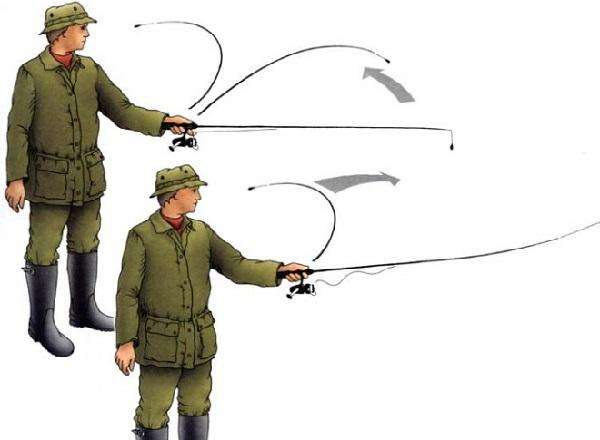
A horizontal or side cast is used in cases of obstacles in the fishing area that do not allow the rod to be positioned vertically. Tree branches hanging over the water are the most common problem, which gives reason to use just such a technique when it is necessary to cast a spinning rod. The fisherman performs these actions in complete similarity to the technique of the previous cast, only the rod is held in a horizontal position and retracted from the side. Before throwing the bait, the angler decides on the casting side, moves the rod to the side and throws a spinner or other bait at the fishing point. The main skill development for executing a throw with this technique is to timely withdraw the finger holding the line on the blank. When performing horizontally, you have to react to removing your finger much faster, and when changing the method from vertical, it is especially difficult to adjust to removing your finger not in a straight line, but from the side. A quick response to the release of the line significantly affects the accuracy and casting distance of the spinning rod.
Pendulum throw
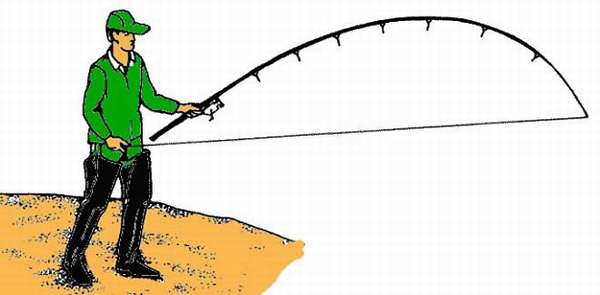
The pendulum throw allows you to throw the bait close, but very accurately to the intended point. It is used mainly for fishing in open windows among aquatic vegetation or spaces among visible areas of snags in the water area. Casting is facilitated by the constraint of performing the above-described techniques. Often such a cast has to be performed on a river bank, completely covered with a wall of vegetation that is several times longer than the length of the rod blank. The bait is released from the tip of the rod ten centimeters. Holding the freed line, the bait is swung parallel to the form and, when swayed towards the reservoir, it is released, placing it in the required place. The technique is complex and requires a certain amount of time to complete it.
Ejection
Ejection is the most complex technique. This type is used when it is completely impossible to implement the three previous ones. The peculiarities of the throw are short distances and relatively low accuracy, but if the place is particularly promising, then you need to try, especially since there is an option for serving. With this method, the angler takes the bait in his hand, pulling the thread of the tackle until the tip of the rod bends and, when he feels the elasticity of the whip, shoots the bait, simultaneously releasing the line from the blank in unison with the bait. The complexity of the technique lies in the fact that the angler has to keep the spinning rod in a tense state when casting, while simultaneously controlling the bait and the clamped fishing line.
Gallery: sliding float for long casting (25 photos)
Characteristics of a sliding float for long casting
The sliding float looks like a ballistic missile combined with an arrow. The arrow-shaped section of the float can reach 200-500 mm in length, and its thickened segment - 20-100 mm . A fixed float can have a lifting capacity of about 3 grams and is equipped with a long keel made of metal or plastic and a thick antenna. Sliding floats have a thinner antenna and usually have a lower carrying capacity.
In equipment with a sliding float, the fishing line must be submerged. For fishing with such a float, a standing or low-current reservoir is suitable. A plug rod with 10-16 rings and light equipment for better casting are used. A reel holder with rings that slide along the handle is a better choice. Reels are suitable for sports ones with a minimum number of bearings, so as not to make the structure heavier. The thickness of the fishing line should be 0.08-0.18 mm , and the length should be 60-80 meters.
We also recommend reading:
Budget spinning reels Riobi Exiya Features of crucian carp killer gear and how to make such equipment Diagram of how to learn how to tie a hook to a fishing line Features of fishing with a retractable leash, selection of gear and installation
A tackle with a sliding float must have stoppers consisting of three elements: a sliding bead, a stopper assembly and a lower stopper pellet. A stopper at the bottom prevents sliding towards the main load. A stop bead fixed in front of the float element prevents the unit from getting into the keel cavity. After the bead, a locking knot with a 2 cm mustache is knitted from the thread.
Fishing equipment with a sliding float
For comfortable and productive fishing, you need to prepare the right gear.
Selection of sinkers
Fishing with one sinker is only possible in calm water. For bodies of water with current, it is necessary to use several weights arranged to reduce weight. The main sinker, located at the very top, plays the role of a lower stopper and must be well attached to the fishing line. It is recommended to place a rubber or silicone tube on top of the main weight to cushion the float.
Selection of fishing line
The thickness of the chosen fishing line increases depending on the type of fish and the casting distance, but the base should always be thicker than the leader. The fishing line is threaded through a wire eye or passed through the body of the float through a special channel. For strong currents, it is better to choose a load-resistant float with a channel. For match fishing, a fishing line with a diameter of 0.18 to 0.20 mm is used.
Selection of swivels
The main function of the swivel is to prevent the line from twisting . It is important when fishing using a spinner or spinning rod. Twisting of the fishing line occurs due to the rapid rotation of the spinner, which reduces its strength by up to 70%, and periodic winding on the spool. The swivel helps maintain the strength of the fishing line and prevents it from twisting. Carabiners with special clasps also simplify the process of changing bait.
How to cast a fishing rod
When you have everything you need in your hands, namely, gear prepared for fishing, you need to know how to cast a fishing rod. Before casting, you need to hold the rod with your dominant hand. The reel should be lower than the fishing rod itself. The place where the reel attaches to the fishing rod is usually located between the middle and ring fingers, but if the fishing rod feels better between the other fingers (more balanced), then it should be placed as comfortably as possible.
You need to release or wind the line until you get about fifteen centimeters hanging freely from the last upper ring. Next, you need to slowly turn the reel handle until the line is located directly under your index finger.
Ideally, the line should lie in the crook of your index finger. When learning how to cast a fishing rod, you need to remember to open the lock on the reel with your other hand. You need to start with a good firm position so that your legs and shoulders are at right angles to the direction of the fisherman's tracks. Next, you need to point the base of the fishing rod at the target. In one smooth movement, bring the fishing rod to a vertical position. You need to allow the tip of the rod behind the fisherman to bend a little, and, without stopping, point the rod forward. IMPORTANT! When casting, you need to pay attention to the fact that the movement occurs in the elbow and wrist, and not in the shoulder.
When the rod tip is halfway to the target, you need to release the index finger that was holding the fishing line to send the bait to the chosen location. Perhaps the first time everything will not go as smoothly as we would like, but over time the casts will become clear and fast.
Features of a fishing rod for long casting
For fishing with long casting, fishing rods with a long rod , which can reach 3.6-4.5 m. The fishing rod must be sufficiently rigid, but at the same time have little weight. A fast action is used for this type of rig. The knees of the rod bend closer to the top and maintain rigidity in the rest of the rod. This type of structure helps to maximize the distance of casting the bait.
The rod for long casting has the form of a plug design with three elbows. For compactness during transportation, it is better to choose models with 4-6 parts. The handle is made of cork or rubber with a porous texture.
“Match” reels are ideal for long casting due to their long, lightweight spool and small convex drum. This design allows you to use thinner lines.
The softness and reliability of the product depends on the number of bearings on the reel. But with a large number of them, the weight of the fishing rod also increases, which can lead to rapid hand fatigue. Therefore, it is necessary to choose a product for yourself that will be optimal in terms of smoothness and overall weight.
Amateur fishing allows the use of fishing line with a diameter of 0.12-0.18 mm. For sport fishing, the thickness is reduced to 0.1-0.16 mm. A fishing line 60-80 m long is wound onto a reel with a release of 0.5-2 mm from the edge. If you choose a fishing line with a higher density than water, it will sink well without reacting to the wind.
How to cast a spinning rod correctly
Nowadays, equipping a fishing rod with a spinning reel is a classic option for spinning fishing. Therefore, we will understand the throwing technique more thoroughly by working through the algorithm of the fisherman’s actions. Holding the line on the tackle form with your finger, while lowering the bait thirty centimeters from the tip of the rod, open the line handle.
The cord should be in the last ring of the whip, but in no way on the blank. Then a swing is made with a synchronized release of the fishing line when the bait comes in line with the rod blank. In practice, the flight of the bait and the position of the blank, when stopping after the swing, are a directed vector. When the bait is in the water, the line holder is closed.
After closing the line holder, the casting is considered completed and you can begin retrieving. Carrying out the sequence of these manipulations fully solves the question of how to properly cast a spinning rod with a spinning reel.
Depending on what type of reservoir and under what conditions the fishing takes place, the angler uses different types of float rods. Fishing rods for float fishing are divided into 4 categories:
- flight feathers;
- Bolognese;
- match;
- plug-in
Flight feathers are the most common group, used for fishing in stagnant bodies of water or on rivers with moderate currents. The casting range when fishing with fly tackle is determined by the length of the rod, which can range from 3 to 12 m. Due to the limited casting range, fly rods are used to fish in small bodies of water or in places where the channel edge or hole is located in close proximity to the shore.
The Bolognese float rod is used for fishing on rivers with weak and medium currents. This tackle is equipped with a spinning reel and rings, which allows you to fish at some distance from the shore. The length of Bolognese fishing rods ranges from 4 to 8 meters.
We invite you to familiarize yourself with: The Best Companies Manufacturers of Spinning Rods
Match float tackle is used for long-distance fishing. The match fishing rod is equipped with an inertia-free reel and a heavy float with its own weight, which allows you to cast the equipment 30–60 m from the shore. The length of fly rods rarely exceeds 6 m.
A plug rod for float fishing can be used in both standing and flowing reservoirs. It is more often used by sports fishermen, since it requires certain handling skills. Plug fishing rods are equipped with a rubber shock absorber located inside the working part of the rod, which is called the “whale”. The length of such fishing rods reaches 15 m.
The presence of certain elements in the equipment depends on the type of float rod. The blind equipment of a float rod for fly fishing includes:
- connector;
- main line;
- float;
- set of weights;
- leash;
- hook.
The connector is used to attach the main line to the rod and can be made in various versions. The main equipment is concentrated on the main line, which includes a float and a set of sinkers. Floats for fly fishing can have a body of various shapes, equipped with a keel, antenna, and also a ring for passing the fishing line.
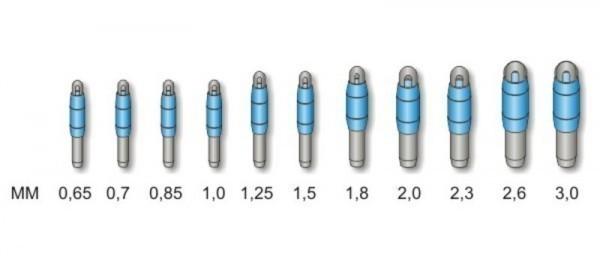
Connectors
A leash is a necessary element that protects the entire equipment from breaking if the hook gets caught. Its diameter is usually 0.02 less than the diameter of the main line. The hook is used to attach bait and ensure reliable hooking. Its size is selected taking into account the type and size of the nozzle.
The equipment of a Bolognese fishing rod differs from that used for fly fishing gear. The equipment of a float rod for fishing in currents consists of the following elements:
- rods with rings;
- inertia-free or inertial coil;
- main line;
- Bolognese float;
- olive sinkers;
- swivel;
- leash;
- hook.
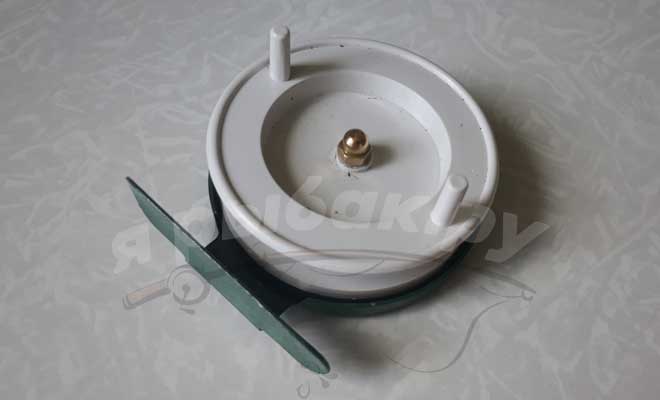
The inertial reel is also suitable for float tackle
The Bologna rig includes a spinning reel of size 3000–3500, on the spool of which a monofilament line with a diameter of 0.15–0.18 mm is wound. It would be good if the reel had a large additional number of bearings, which would allow you to quickly reel out the line after a single hookup. The Bolognese float differs from the fly float in having a greater load capacity and a through hole for passing fishing line.
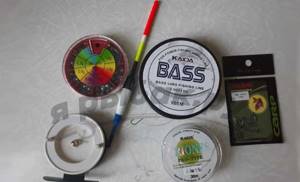
Elements for equipping float tackle
The equipment of the plug tackle differs from the fly version by using thinner lines and light floats, which makes it possible to catch capricious fish. The match gear is characterized by the presence of an inertia-free reel and a heavy float, which has its own carrying capacity and ensures long-distance casting of the nozzle.
The reliability of the tackle, as well as the speed and convenience of replacing the equipment, depend on the method of attaching the fishing line. When assembling the fishing rod, the main fishing line can be attached via a connector or via a reel.
Any fly rig must have a loop at the end, through which it will be attached to the tip of the rod. A connector is used to attach the equipment to a fly fishing rod with a float. There are three types of similar connectors:
- plastic design with lock;
- rope loop;
- a piece of rubber shock absorber.
To attach a fishing line to the tip of a fishing rod without rings, it is most convenient to use a commercial plastic connector. This element has a small clasp that closes after inserting a loop into it. There is a small hole in the connector for attaching to the tip of the fishing rod. The diameter of this hole must correspond to the diameter of the tip of the whip, so the connecting element should be selected when purchasing a fishing rod.
When equipping a float rod with a blind rig, a connector made from a rope loop can be used. To make it you will need:
- take a piece of synthetic rope 5 cm long and 1–2 mm in diameter;
- take a braided cord with a diameter of 0.1–0.12 mm, which will be needed to secure the rope;
- fold the rope in half;
- wind the folded rope to the tip of the whip so that you get a loop with a diameter of 0.5 cm;
- saturate the winding with superglue.
Such a connector is easy to manufacture and will allow for quick replacement of equipment. This design uses a loop-to-loop fastening method.
The third type of connector is a piece of rubber shock absorber, which can be used as bottom or plug rubber. To make it, you will need a piece of elastic 7–10 cm long, one side of which is wound to the tip of the whip with a braided cord, and at the other end a loop is formed for attaching the fishing line. This connector increases the shock-absorbing properties of the rod, which allows you to use thinner fishing line and smaller hooks.
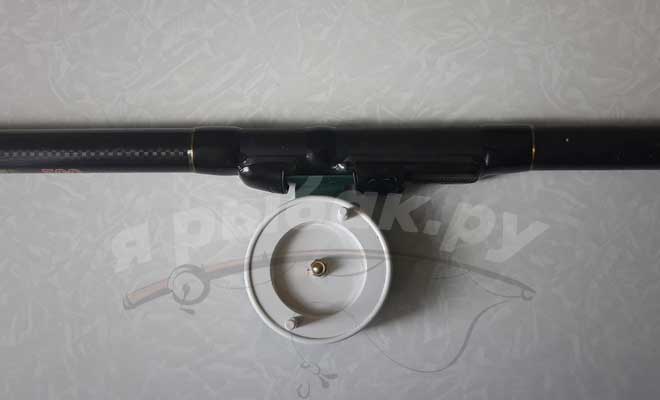
Inertial reel attached to a Bolognese rod
In Bolognese gear, the equipment is attached not to the rod itself, but to the reel that is installed on it. Most Bolognese fishing rods are equipped with a special reel seat designed for installing the reel on the tackle. If the purchased model does not have a reel seat, then you can put the reel on the fishing rod in another way. To assemble a fishing rod and reel you will need:
- drop a little superglue on the part of the reel foot that will be adjacent to the rod;
- install the reel in the center of the butt so that its spool is in line with the first wiring ring;
- fix the coil for 1–2 minutes until the glue dries;
- attach the reel foot to the butt of the rod with a braided cord;
- saturate the winding with superglue.
We suggest you read: How to make a float for a fishing rod
The tackle can be used after the glue has completely dried. A self-tightening loop can be used to attach the main line to the reel spool.
The float is the main element in the float tackle, responsible not only for timely registration of bites, but also involved in delivering the bait to the fishing point. Its performance characteristics largely depend on the method of fastening the float.
Float selection
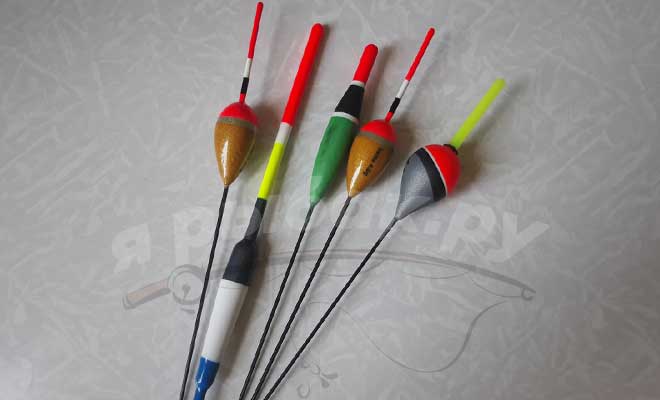
Professionals often prefer a float weighing up to 2 grams
The fly tackle is equipped with a small float made of balsa or other materials with a high degree of buoyancy. The carrying capacity of a float for a fishing rod with blind equipment rarely exceeds 8 g. This bite alarm consists of the following elements:
- bodies;
- keel;
- antennas;
- ring for passing fishing line.
For standing water, oblong-shaped floats are used. When fishing in the current, preference should be given to spherical signaling devices. In fly fishing, the float serves only as a bite alarm and does not take part in casting the equipment.
All Bolognese floats have a drop-shaped or spherical shape, more suitable for fishing with a float rod in moderate current conditions. Bolognese signaling devices differ from flywheel signaling devices in having a greater load capacity. In addition, in the Bolognese version, the line is passed not through a wire ring, but through a hole located in the body of the float, which avoids damage to the alarm during casting and vigorous hooking.
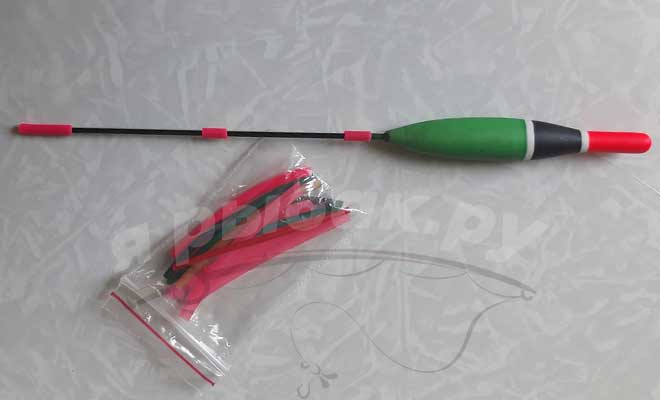
Attaching the float to the fishing line using cambrics
For match fishing, floats 20–40 cm long are used, which have their own weight and lower attachment point. This design gives the alarms good aerodynamics, which allows fishing at a distance of 40–60 m from the shore. The load capacity of match floats ranges from 2 to 25 g.
The plug-in equipment of a fishing rod for fishing in still water requires the use of light floats with a carrying capacity of no more than 1 g. For pole fishing in strong currents, flat floats are used that have excellent hydrodynamics and can withstand the directional flow of water. The load capacity of flat floats can vary from 3 to 15 g.
Features of choosing a float
There is a large selection of sliding floats that have a single attachment point . These floats are suitable for small currents or standing water. The choice of model depends on the behavior and weight of the fish, as well as the fishing depth. The float element with a single attachment point provides a more accurate hookup and makes it easier to spot a bite on the rise. They are more accurate and smooth when casting.
If the current is strong, fishing with a sliding float will be difficult. He will dive, colliding with any debris that the current brings and create a false biting effect.
Installation of a fishing rod for long casting with a sliding float
Proper collection of float gear for long casting directly contributes to successful fishing. Sinkers are the most important element of fishing rod equipment. For sliding equipment, they are located at a close distance from the leash , and for fixed equipment, closer to the float. The role of sinkers is played by pellets of different shapes. They are selected according to the type of float. The weight of the sinker is related to the diameter of the fishing line.
Sinkers are distributed by weight. Heavier olive-like elements are fixed on top, and smaller pellets below. Heavy weights attract the equipment to the bottom, and small ones stabilize the leader and hooks.
Using carabiners, the leash is attached to the fishing line. The use of protective clips that secure the hook with the bait will prevent the line from tangling when casting.
A cross-lock fastener is attached to the end of a 75 cm long fishing line . A clip is attached above it for protection, then a bead is put on. Next, without clamping, a crimp sleeve is installed and another bead is placed on top. The line goes into the eye of the swivel and is passed through the last bead. An additional swivel is attached to the free end of the fishing line. A leash with an existing hook 60 cm long is attached to the remaining eye on the first swivel.
How to knit
If the hook is tied correctly, the monofilament practically does not lose its breaking load at the knot. To properly attach the hook you need:
- turn the hook with the back side facing you;
- pass the end of the monofilament through the eye and attach it to the fore-end;
- point the end of the fishing line towards the eye;
- wrap the monofilament around the shank 5–6 times and pass its tip into the loop formed at the bend of the hook;
- moisten with saliva and tighten.
Wetting the assembly when tightening will prevent it from burning out. The tip remaining after tying must be cut off.

